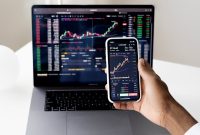
In the world of finance and investment, Exchange-Traded Funds (ETFs) have become a cornerstone for both novice and seasoned investors. As we approach 2025, the landscape of ETF investment is continually evolving, offering a multitude of strategies that can enhance and diversify your portfolio. Drawing inspiration from the holistic principles of healing touch, this guide aims to provide you with insights into optimizing your investment strategies with ETFs.
Understanding ETFs: The Basics
ETFs are investment funds that trade on stock exchanges, similar to stocks. They hold assets such as stocks, commodities, or bonds and generally operate with an arbitrage mechanism designed to keep trading close to its net asset value, though deviations can occasionally occur. ETFs provide investors with a way to diversify their portfolios without needing to purchase individual assets, offering exposure to a range of sectors and industries.
Top ETF Investment Strategies for 2025
With the ever-changing financial landscape, it is essential to adopt strategies that align with your investment goals and risk tolerance. Here are some of the top ETF investment strategies you can consider to maximize your portfolio in 2025.
Sustainable and ESG Investing
Environmental, Social, and Governance (ESG) investing focuses on companies that prioritize sustainability and ethical practices. In 2025, ESG-focused ETFs are expected to gain further traction as global awareness of climate change and corporate responsibility increases. Investors looking to make a positive impact while potentially reaping financial rewards should consider integrating ESG ETFs into their portfolios.
- Example: Look for ETFs that track indices focused on renewable energy, sustainable agriculture, and companies with strong governance policies.
Thematic Investing
Thematic investing involves focusing on specific sectors or trends that you believe will outperform the market. Themes like technology innovation, healthcare advancements, and digital finance are poised for significant growth in the coming years. By investing in thematic ETFs, you can gain exposure to these burgeoning sectors.
- Example: Consider ETFs that focus on technology, biotechnology developments, or the expanding digital payment landscape.
Dividend Growth ETFs
For those seeking stable income, dividend growth ETFs can be an attractive option. These ETFs invest in companies with a history of paying and increasing dividends over time. They provide a steady income stream and can be a resilient choice in volatile markets.
- Example: Target ETFs that hold companies with a robust track record of dividend growth, such as consumer staples, utilities, and healthcare sectors.
Global Diversification
Incorporating international ETFs into your portfolio can help spread risk and tap into emerging markets. As the global economy continues to evolve, countries outside the U.S. and Europe offer unique investment opportunities that can enhance portfolio performance.
- Example: Explore ETFs that provide exposure to Asian markets, Latin America, or emerging European economies.
Factor-Based Investing
Factor-based, or smart beta, investing involves selecting ETFs that target specific investment factors such as value, growth, momentum, or volatility. By utilizing factor-based ETFs, investors can customize their portfolios to align with personal investment styles and market conditions.
- Example: Choose ETFs that focus on value investing or those that capitalize on market momentum for potentially enhanced returns.
Integrating Healing Touch Principles into Your Investment Strategy
Much like the principles of healing touch, which emphasize harmony and balance, successful investment strategies often require a balanced approach. Here are some insights inspired by healing touch that can be applied to your ETF investment strategies:
Balance and Harmony
Just as healing touch practitioners seek to balance energy fields, investors should strive for a balanced portfolio. This means diversifying across various asset classes, sectors, and geographic regions to mitigate risk and enhance returns.
Mindfulness and Patience
Investing, much like healing touch, requires mindfulness and patience. Avoid impulsive decisions driven by market hype. Instead, take a thoughtful approach when selecting ETFs, focusing on long-term growth and stability.
Continuous Learning
In both healing touch and investing, continuous learning and adaptation are crucial. Stay informed about market trends and economic indicators, and be willing to adjust your strategies as needed to align with changing market conditions.
Common Mistakes to Avoid in ETF Investing
Even seasoned investors can fall into common traps when investing in ETFs. Here are a few mistakes to watch out for:
- Over-concentration: Diversification is key. Avoid concentrating too heavily in one sector or geography.
- Ignoring costs: Pay attention to the expense ratios of ETFs, as high fees can erode returns over time.
- Performance chasing: Avoid selecting ETFs solely based on past performance, as it does not guarantee future results.
FAQ
What are the benefits of investing in ETFs? ETFs offer diversification, liquidity, and typically lower fees than mutual funds. They provide exposure to various markets and sectors, making them a versatile investment tool.
How do I choose the right ETF for my portfolio? Consider your investment goals, risk tolerance, and market outlook. Research the ETF’s holdings, performance history, and expense ratio to ensure it aligns with your strategy.
Are there tax advantages to investing in ETFs? ETFs can be more tax-efficient than mutual funds due to their structure, which often results in fewer capital gains distributions.
Can I invest in ETFs if I’m a beginner? Yes, ETFs are suitable for beginners due to their simplicity and diversification benefits. Start with broad market or index ETFs to gain exposure while you learn more about different asset classes.
How often should I review my ETF portfolio? Regularly review your portfolio, at least annually, to ensure it aligns with your financial goals and market conditions. Adjust as needed based on changes in your life circumstances or market trends.
Conclusion
As we move further into 2025, the possibilities for ETF investment continue to expand. By incorporating strategies such as sustainable investing, thematic exposure, and global diversification, you can build a robust portfolio tailored to your investment goals. Embrace the principles of balance and mindfulness inspired by healing touch to navigate the complexities of the financial markets with confidence and poise.
Remember, successful investing is a journey that requires patience, continuous learning, and a willingness to adapt to changing circumstances. By staying informed and making thoughtful decisions, you can maximize your ETF investments and achieve financial well-being.


